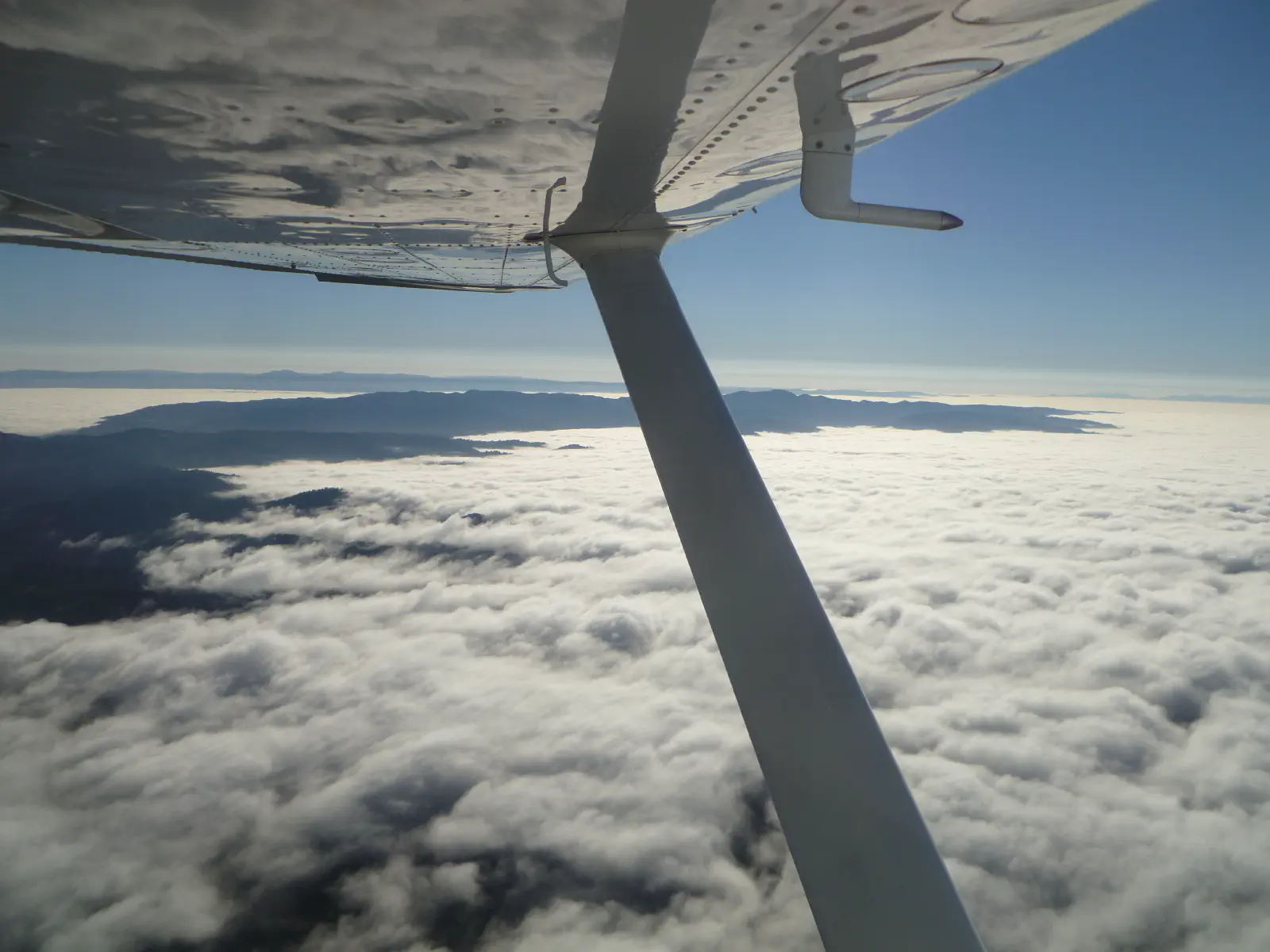IFR - KSQL to KSNS
After passing my Instrument Rating Airman Knowledge Test last May, I began working through the flight training over the summer. Unfortunately work and life just got in the way but I have recently picked up the training again and will hopefully be able to complete the complete certification this time around.
I had a training flight scheduled with my instructor, Martin Michaud, this past Friday which happened to coincide with the arrival of an arctic storm system blowing into the bay area. As I was watching the weather come in, I pretty much gave up hope on making our flight. The way things were trending, it looked as if the icing layer would be dropping down to 4,000’ MSL.
On Thursday evening I was going over the weather for a planned flight to Stockton (KSCK) and, based on the AIRMETs available at the time, it appeared that the icing layer would be down to 5,000’ MSL for our area, actually for a significant portion of the western U.S. Ceilings were forecast to be in the 2,000’ to 3,000’ range which would be more than adequate but winds in the Stockton area were forecast to be 12 knots gusting to 20 which would make approaches difficult for a fairly green IFR student.
I got on the phone with Martin to discuss the forecast mentioning my findings. When we discussed the icing forecast, he directed me to the Aviation Weather Service’s Advanced Digital Data Service icing forecast. The graphical forecast closest to our time of departure had the icing layer between 9,000’ and 10,000’ which would be well above our altitude. The winds at KSCK were an issue so we looked at Salinas (KSNS) which had more favorable winds (i.e. no significant gusts forecast). After discussing the weather and route a little further we decided to check back in before I left for the airport in the morning. If the forecast held with no significant changes we would make the trip.
When I woke up and checked the weather, the forecast held so I headed to the airport to get the plane ready. I’m not used to flying in the rain so this was my first pre-flight experience during rain. I brought an umbrella to cover the fuel tank filler while I checked the fuel quality and quantities. After wiping moisture off the area around the fuel cap, I was able to rest the umbrella over the area while I performed my pre-flight tasks. It worked out so well, I’m convinced I need to get an umbrella to keep with my pre-flight tools.
Once Martin arrived, we discussed the route he filed for us (KSQL direct KSNS), pulled the plane out and got started. While waiting for the oil temperature to come up we did a ground VOR check using the Woodside (OSI) VOR. My excitement really began to build when I requested taxi clearance to runway 12 and tacked on “filed IFR to Salinas” at the end of my request. After completing the run-up, the tower was ready to give me my clearance and I was ready to copy:
N96988 cleared to Salinas airport, on departure maintain runway heading climb 3700’ expect radar vectors Woodside, Victor 25, Salinas, expect 6000’ 5 minutes after departure Norcal departure on 135.65 squawk 4515.
After a few corrections to what I had written down, our very patient controller gave me the “good read back” response. For some reason my brain seems to drop the hundreds of feet off clearances so I wrote down something like 3000’. This would happen again with an enroute clearance on our way to Salinas. Obviously this is something I need to correct as I progress. With our clearance in hand, I punched our route into the GNS 480 and really appreciated its ability to plug in airways (not available on the 430’s as far as I’m aware). Once Martin and I concurred on our readiness for our departure I got to make a memorable request to the tower:
San Carlo Tower, Skylane 96988 ready for IFR release.
Apparently not many people were in the sky at the time so we were quickly cleared for departure and up we went. Shortly after departure we were handed off to Norcal departure. Norcal gave us a vector to pick up V25 (victor 25) and cleared us to 6,000’ with no delay through 3,000’. I stumbled on the read-back of the “no delay” clearance so Martin helpfully stepped in and gave the controller the proper read-back. When listening to clearances on the radio it’s difficult to read-back instructions you’ve never heard before. As you hear them over and over again, you learn what to expect and it becomes easier. This is why we fly with qualified instructors before we do this by ourselves!
We entered our first cloud layer around 1,800’ and came out of it around 2,400’. As we passed through 3,000’ we were back in the clouds and I immediately realized why the mantra of “trust your instruments” is hammered into an instrument pilot’s brain. When we entered the clouds my butt told me we were in a bank to the left and it told me that with a great deal of conviction. The instruments told me the exact opposite, we were in fact in a bank to the right. I cross checked the directional gyro with the attitude indicator and turn coordinator and they all agreed, we were in a standard rate turn to the right. My brain went with what the instruments were telling me and my butt grudgingly followed suit.
Shortly after reaching 6,000’ we picked up V25, got handed off to another Norcal controller and started to pick up the ATIS (automated weather broadcast) for Salinas. The winds were favoring runway 13 so we requested the RNAV (GPS) Rwy 13 approach. We were cleared direct MOVER IAF (initial approach fix) and instructed to cross MOVER at 4,000’. I began our descent and we crossed MOVER at 4,000’ at which point the approach had us descend to 3,200’ to the EWTOF waypoint on the approach. We got down to 3,200’ prior to reaching EWTOF but I didn’t stabilize our altitude very well. We descended below 3,200’ and oscillated between being below and right at 3,200’. I need to work on climbing to and descending to an altitude and sticking to it, with particular attention to not going below a target altitude.
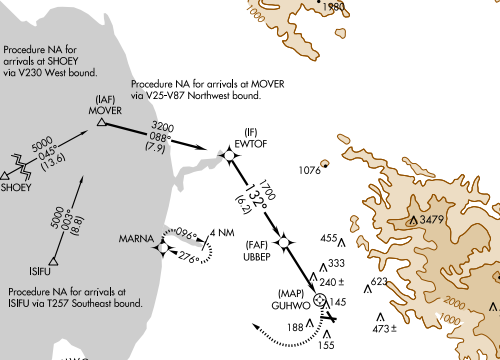
Shortly after EWTOF we broke through the clouds and would you believe it, there was a runway off in the distance! The final approach and landing was uneventful, so much so that Martin had the opportunity to look around and marvel at the amount of green paint used on a house under the final approach path. Here you can see what our route looked liked from Flight Aware:
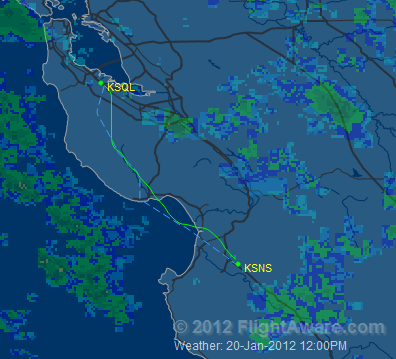
Martin had us filed direct back to San Carlos so once we were off the runway we received clearance to taxi back to the runway and the controller worked on our clearance request. Once we were ready to copy our clearance"
N96988 cleared to San Carlos via the Salinas Two Departure, radar vectors, JEFNY, climb to 6,000’ expect Norcal on 133.0 squawk 4551.
After some button smashing I realized that the Salina Two Departure is not in my GPS’ data set. I believe this is due to there not being any fixes on the departure other than 255° radial from the Salinas VOR but I’m not sure. We would be vectored by Norcal once we were up and then go direct JEFNY so I plugged KSNS → JEFNY → KSQL into our flightplan. Once we received our IFR release for Salinas tower, we were off.
I had the 255° radial set in the NAV1 radio but I completely overshot it by not taking into account how close we were to the VOR. As I started to swing back to pick it up, Norcal gave me a vector that saved me from back tracking and we were soon headed direct to JEFNY and we were soon back in the clouds.
As we were approaching San Jose, Norcal started to give me “short vectors for sequencing.” While I caught the vector I was given, I hadn’t caught the bit about sequencing but Martin was able to clue me in. They essentially gave me a few turns off my primary course to make way for other traffic.
I’m not 100% sure but I think it was here that I made a few noteworthy errors. While turning toward a vector I thought it would be a good idea to get ahead of the plane and get the approach plate ready for the San Carlos. Martin quickly corrected my error with a simple but direct “not while you’re making a turn.” Turns need to be coordinated and well executed, it is not the time to be distracted with other activities. Noted.
My next error was a little more dramatic. At some point I became fixated on my kneeboard. I may have been trying to read my approach speeds but I’m not sure. What I do know is that when I eventually looked at my instruments, the plane was no longer on course, the wings were not level and we were descending. Just before Martin started to intervene, I began the recovery and got us back on track. Much like my butt/instrument conflict on our way to Salinas, this experience taught me a lot. At no point while I was fixated on my kneeboard did my butt ever chime in to say we were no longer straight and level. This reinforces the need to be diligent in monitoring instruments while performing other tasks, flying the plane takes priority over everything else.
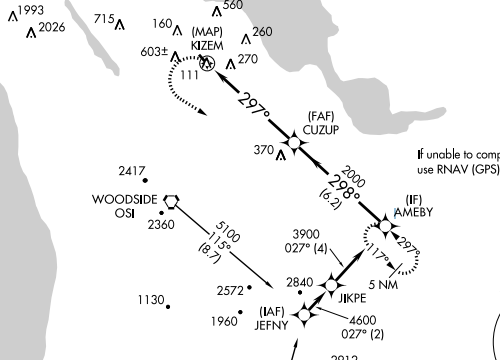
As we approached JEFNY, we were cleared for the RNAV (GPS) Z Rwy 30 approach. Winds were favoring runway 12 so we would need to “circle to land, remain north of the field”. For some reason I had pictured a “circle to land” approach as being something as dramatic as spiraling down over the field. Fortunately it’s nothing more than entering the traffic pattern and following the pattern around to the proper runway.
As we approached Palo Alto we came out of the clouds to see a stubby little rainbow climbing out of the sky and touching down somewhere near the Stanford campus. The more I work on this rating, the more I’m learning about the unique sights you get to see and this one was amazing. I didn’t let the rainbow distract me from the work at hand and once again we made an uneventful landing at San Carlos.
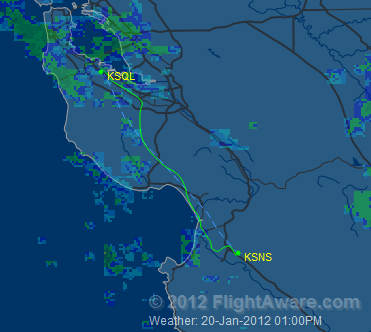
What an amazing flight, flying into real IMC (instrument meteorological conditions) turned out to be an excellent training mission. I gained confidence from actually flying into clouds while at the same time finding areas where I need to improve before I can even think of doing this myself. I simply can’t wait to go up again.
